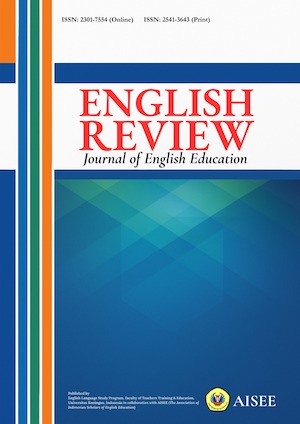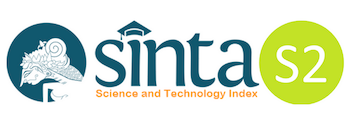IMPROVING ENGLISH SPEAKING ABILITY THROUGH HYPNOCATIVE SPEECH METHOD
Abstract
The objective of this research is to identify the improvement of students’ English speaking ability through hypnocative speech. The research was conducted at Mantika Language Center. This action research was carried out in two cycles in which each cycle consists of four phases of planning, action, observation, and reflection. Here, the researcher guided the instructor as students’ collaborators in implementing hypnocative speech method to improve students’ English speaking ability. The data collection techniques used were observation, questionnaire, test, teacher's diary, observer’s daily journal, interviews, and audiotape recordings. The data consist of collected accent, grammar, fluency, vocabulary and comprehension. The data have been collected through a critical comparative analysis technique by combining and simultaneously comparing the result of the first cycle until the last cycle. As result, it was found that implementing hypnocative speech in the teaching and learning process can improve students’attitudes and the outcome of their speaking ability. Here, the students can communicate fluently, do not feel afraid, and have more courage to speak the language communicatively, harmoniously, and correctly. Precisely, the implementation of hypnocative speech method can increase students’ speaking ability, at least 30.31.
Keywords: action research; speaking ability; hypnocative speech.References
Brown, D. (2007). Language assessment: Principles and classroom practice. White Plains, NY:Pearson Education.
Bygate, M. (2001). Researching pedagogic tasks: Second language learning, teaching, and testing. UK: Longman.
Harmer, J. (2001). The practice of language teaching. White Plains, NY: Pearson Education.
Harmer, J. (2000). How to teach English. London: Longman.
Heaton, J. B. (1989). Writing English language test. London: Longman.
Kember, D. (2000). Action learning and action research: Improving the quality of teaching and learning. London: Biddles ltd.
Nunan, D. (1992). Research methods in language learning. Cambridge: Cambridge University Press.
Sugandi, A. (2004). Teori pembelajaran. Semarang: UPT MKK UNNES.
Tarigan, H. G. (1985). Berbicara sebagai suatu keterampilan berbahasa. Bandung: Angkasa.
Valette, R. M. (1967). Modern language testing. New York: Harcourt Brace Javanovich.
All articles published in English Review: Journal of English Education (ERJEE) are licensed under the Creative Commons Attribution 4.0 International License (CC BY 4.0).
Copyright Ownership
Authors retain the copyright of their articles and grant ERJEE the right of first publication. The journal is granted a non-exclusive license to publish, reproduce, and distribute the article in any format, medium, or platform, provided that proper credit is given to the original authors.
License Terms – CC BY 4.0
Under the Creative Commons Attribution 4.0 International License, others are free to:
- Share — copy and redistribute the material in any medium or format
- Adapt — remix, transform, and build upon the material for any purpose, even commercially
As long as they:
- Provide appropriate credit to the original author(s) and source
- Provide a link to the license (https://creativecommons.org/licenses/by/4.0/)
- Indicate if any changes were made
There are no restrictions on the reuse, reproduction, or adaptation of published articles as long as attribution is properly given.
Author Warranties
By submitting a manuscript to ERJEE, authors confirm that:
- The work is original and does not infringe any existing copyright.
- The manuscript has not been previously published and is not under consideration elsewhere.
- All sources and references are appropriately acknowledged.
- Necessary permissions have been obtained for any copyrighted materials used.









